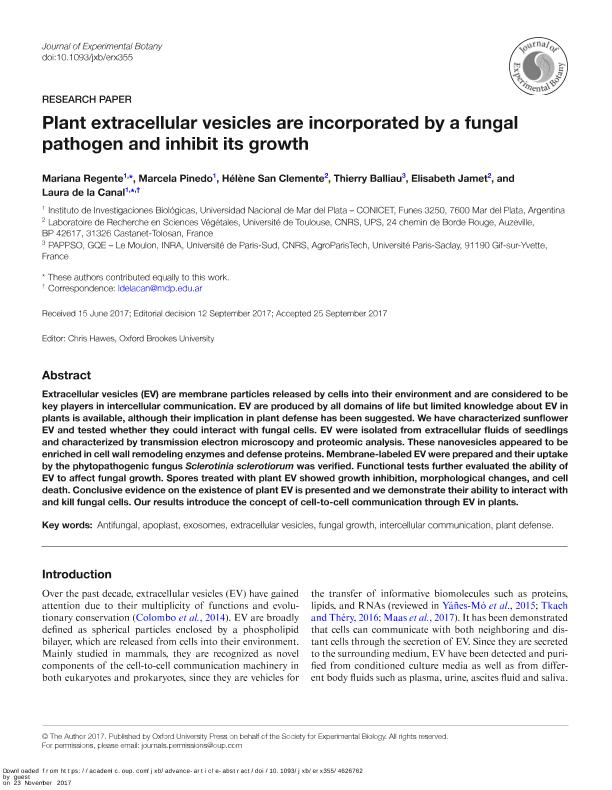Artículo
Plant extracellular vesicles are incorporated by a fungal pathogen and inhibit its growth
Regente, Mariana Clelia ; Pinedo, Marcela Lilian; Clemente, Hélène San; Balliau, Thierry; Jamet, Elisabeth; de la Canal, Laura
; Pinedo, Marcela Lilian; Clemente, Hélène San; Balliau, Thierry; Jamet, Elisabeth; de la Canal, Laura
 ; Pinedo, Marcela Lilian; Clemente, Hélène San; Balliau, Thierry; Jamet, Elisabeth; de la Canal, Laura
; Pinedo, Marcela Lilian; Clemente, Hélène San; Balliau, Thierry; Jamet, Elisabeth; de la Canal, Laura
Fecha de publicación:
23/09/2017
Editorial:
Oxford University Press
Revista:
Journal of Experimental Botany
ISSN:
0022-0957
Idioma:
Inglés
Tipo de recurso:
Artículo publicado
Clasificación temática:
Resumen
Extracellular vesicles (EV) are membrane particles released by cells into their environment and are considered to be key players in intercellular communication. EV are produced by all domains of life but limited knowledge about EV in plants is available, although their implication in plant defense has been suggested. We have characterized sunflower EV and tested whether they could interact with fungal cells. EV were isolated from extracellular fluids of seedlings and characterized by transmission electron microscopy and proteomic analysis. These nanovesicles appeared to be enriched in cell wall remodeling enzymes and defense proteins. Membrane-labeled EV were prepared and their uptake by the phytopathogenic fungus Sclerotinia sclerotiorum was verifed. Functional tests further evaluated the ability of EV to affect fungal growth. Spores treated with plant EV showed growth inhibition, morphological changes, and cell death. Conclusive evidence on the existence of plant EV is presented and we demonstrate their ability to interact with and kill fungal cells. Our results introduce the concept of cell-to-cell communication through EV in plants.
Archivos asociados
Licencia
Identificadores
Colecciones
Articulos(IIB)
Articulos de INSTITUTO DE INVESTIGACIONES BIOLOGICAS
Articulos de INSTITUTO DE INVESTIGACIONES BIOLOGICAS
Citación
Regente, Mariana Clelia; Pinedo, Marcela Lilian; Clemente, Hélène San; Balliau, Thierry; Jamet, Elisabeth; et al.; Plant extracellular vesicles are incorporated by a fungal pathogen and inhibit its growth; Oxford University Press; Journal of Experimental Botany; 68; 20; 23-9-2017; 5485-5495
Compartir
Altmétricas



